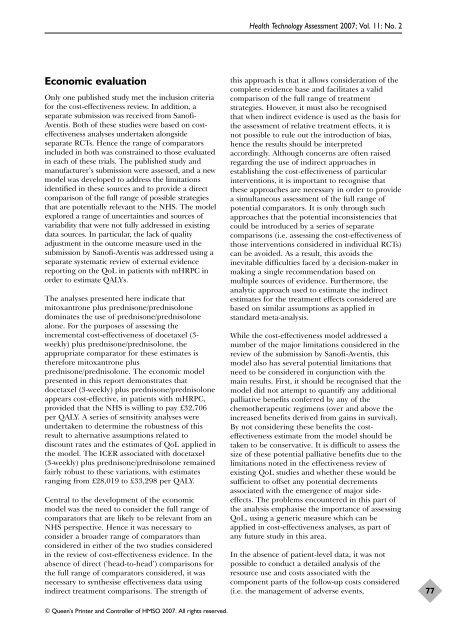Docetaxel with prednisone or prednisolone for the treatment of ...
Docetaxel with prednisone or prednisolone for the treatment of ...
Docetaxel with prednisone or prednisolone for the treatment of ...
Create successful ePaper yourself
Turn your PDF publications into a flip-book with our unique Google optimized e-Paper software.
Economic evaluation<br />
Only one published study met <strong>the</strong> inclusion criteria<br />
f<strong>or</strong> <strong>the</strong> cost-effectiveness review. In addition, a<br />
separate submission was received from San<strong>of</strong>i-<br />
Aventis. Both <strong>of</strong> <strong>the</strong>se studies were based on costeffectiveness<br />
analyses undertaken alongside<br />
separate RCTs. Hence <strong>the</strong> range <strong>of</strong> comparat<strong>or</strong>s<br />
included in both was constrained to those evaluated<br />
in each <strong>of</strong> <strong>the</strong>se trials. The published study and<br />
manufacturer’s submission were assessed, and a new<br />
model was developed to address <strong>the</strong> limitations<br />
identified in <strong>the</strong>se sources and to provide a direct<br />
comparison <strong>of</strong> <strong>the</strong> full range <strong>of</strong> possible strategies<br />
that are potentially relevant to <strong>the</strong> NHS. The model<br />
expl<strong>or</strong>ed a range <strong>of</strong> uncertainties and sources <strong>of</strong><br />
variability that were not fully addressed in existing<br />
data sources. In particular, <strong>the</strong> lack <strong>of</strong> quality<br />
adjustment in <strong>the</strong> outcome measure used in <strong>the</strong><br />
submission by San<strong>of</strong>i-Aventis was addressed using a<br />
separate systematic review <strong>of</strong> external evidence<br />
rep<strong>or</strong>ting on <strong>the</strong> QoL in patients <strong>with</strong> mHRPC in<br />
<strong>or</strong>der to estimate QALYs.<br />
The analyses presented here indicate that<br />
mitoxantrone plus <strong>prednisone</strong>/<strong>prednisolone</strong><br />
dominates <strong>the</strong> use <strong>of</strong> <strong>prednisone</strong>/<strong>prednisolone</strong><br />
alone. F<strong>or</strong> <strong>the</strong> purposes <strong>of</strong> assessing <strong>the</strong><br />
incremental cost-effectiveness <strong>of</strong> docetaxel (3weekly)<br />
plus <strong>prednisone</strong>/<strong>prednisolone</strong>, <strong>the</strong><br />
appropriate comparat<strong>or</strong> f<strong>or</strong> <strong>the</strong>se estimates is<br />
<strong>the</strong>ref<strong>or</strong>e mitoxantrone plus<br />
<strong>prednisone</strong>/<strong>prednisolone</strong>. The economic model<br />
presented in this rep<strong>or</strong>t demonstrates that<br />
docetaxel (3-weekly) plus <strong>prednisone</strong>/<strong>prednisolone</strong><br />
appears cost-effective, in patients <strong>with</strong> mHRPC,<br />
provided that <strong>the</strong> NHS is willing to pay £32,706<br />
per QALY. A series <strong>of</strong> sensitivity analyses were<br />
undertaken to determine <strong>the</strong> robustness <strong>of</strong> this<br />
result to alternative assumptions related to<br />
discount rates and <strong>the</strong> estimates <strong>of</strong> QoL applied in<br />
<strong>the</strong> model. The ICER associated <strong>with</strong> docetaxel<br />
(3-weekly) plus <strong>prednisone</strong>/<strong>prednisolone</strong> remained<br />
fairly robust to <strong>the</strong>se variations, <strong>with</strong> estimates<br />
ranging from £28,019 to £33,298 per QALY.<br />
Central to <strong>the</strong> development <strong>of</strong> <strong>the</strong> economic<br />
model was <strong>the</strong> need to consider <strong>the</strong> full range <strong>of</strong><br />
comparat<strong>or</strong>s that are likely to be relevant from an<br />
NHS perspective. Hence it was necessary to<br />
consider a broader range <strong>of</strong> comparat<strong>or</strong>s than<br />
considered in ei<strong>the</strong>r <strong>of</strong> <strong>the</strong> two studies considered<br />
in <strong>the</strong> review <strong>of</strong> cost-effectiveness evidence. In <strong>the</strong><br />
absence <strong>of</strong> direct (‘head-to-head’) comparisons f<strong>or</strong><br />
<strong>the</strong> full range <strong>of</strong> comparat<strong>or</strong>s considered, it was<br />
necessary to syn<strong>the</strong>sise effectiveness data using<br />
indirect <strong>treatment</strong> comparisons. The strength <strong>of</strong><br />
© Queen’s Printer and Controller <strong>of</strong> HMSO 2007. All rights reserved.<br />
Health Technology Assessment 2007; Vol. 11: No. 2<br />
this approach is that it allows consideration <strong>of</strong> <strong>the</strong><br />
complete evidence base and facilitates a valid<br />
comparison <strong>of</strong> <strong>the</strong> full range <strong>of</strong> <strong>treatment</strong><br />
strategies. However, it must also be recognised<br />
that when indirect evidence is used as <strong>the</strong> basis f<strong>or</strong><br />
<strong>the</strong> assessment <strong>of</strong> relative <strong>treatment</strong> effects, it is<br />
not possible to rule out <strong>the</strong> introduction <strong>of</strong> bias,<br />
hence <strong>the</strong> results should be interpreted<br />
acc<strong>or</strong>dingly. Although concerns are <strong>of</strong>ten raised<br />
regarding <strong>the</strong> use <strong>of</strong> indirect approaches in<br />
establishing <strong>the</strong> cost-effectiveness <strong>of</strong> particular<br />
interventions, it is imp<strong>or</strong>tant to recognise that<br />
<strong>the</strong>se approaches are necessary in <strong>or</strong>der to provide<br />
a simultaneous assessment <strong>of</strong> <strong>the</strong> full range <strong>of</strong><br />
potential comparat<strong>or</strong>s. It is only through such<br />
approaches that <strong>the</strong> potential inconsistencies that<br />
could be introduced by a series <strong>of</strong> separate<br />
comparisons (i.e. assessing <strong>the</strong> cost-effectiveness <strong>of</strong><br />
those interventions considered in individual RCTs)<br />
can be avoided. As a result, this avoids <strong>the</strong><br />
inevitable difficulties faced by a decision-maker in<br />
making a single recommendation based on<br />
multiple sources <strong>of</strong> evidence. Fur<strong>the</strong>rm<strong>or</strong>e, <strong>the</strong><br />
analytic approach used to estimate <strong>the</strong> indirect<br />
estimates f<strong>or</strong> <strong>the</strong> <strong>treatment</strong> effects considered are<br />
based on similar assumptions as applied in<br />
standard meta-analysis.<br />
While <strong>the</strong> cost-effectiveness model addressed a<br />
number <strong>of</strong> <strong>the</strong> maj<strong>or</strong> limitations considered in <strong>the</strong><br />
review <strong>of</strong> <strong>the</strong> submission by San<strong>of</strong>i-Aventis, this<br />
model also has several potential limitations that<br />
need to be considered in conjunction <strong>with</strong> <strong>the</strong><br />
main results. First, it should be recognised that <strong>the</strong><br />
model did not attempt to quantify any additional<br />
palliative benefits conferred by any <strong>of</strong> <strong>the</strong><br />
chemo<strong>the</strong>rapeutic regimens (over and above <strong>the</strong><br />
increased benefits derived from gains in survival).<br />
By not considering <strong>the</strong>se benefits <strong>the</strong> costeffectiveness<br />
estimate from <strong>the</strong> model should be<br />
taken to be conservative. It is difficult to assess <strong>the</strong><br />
size <strong>of</strong> <strong>the</strong>se potential palliative benefits due to <strong>the</strong><br />
limitations noted in <strong>the</strong> effectiveness review <strong>of</strong><br />
existing QoL studies and whe<strong>the</strong>r <strong>the</strong>se would be<br />
sufficient to <strong>of</strong>fset any potential decrements<br />
associated <strong>with</strong> <strong>the</strong> emergence <strong>of</strong> maj<strong>or</strong> sideeffects.<br />
The problems encountered in this part <strong>of</strong><br />
<strong>the</strong> analysis emphasise <strong>the</strong> imp<strong>or</strong>tance <strong>of</strong> assessing<br />
QoL, using a generic measure which can be<br />
applied in cost-effectiveness analyses, as part <strong>of</strong><br />
any future study in this area.<br />
In <strong>the</strong> absence <strong>of</strong> patient-level data, it was not<br />
possible to conduct a detailed analysis <strong>of</strong> <strong>the</strong><br />
resource use and costs associated <strong>with</strong> <strong>the</strong><br />
component parts <strong>of</strong> <strong>the</strong> follow-up costs considered<br />
(i.e. <strong>the</strong> management <strong>of</strong> adverse events,<br />
77
















